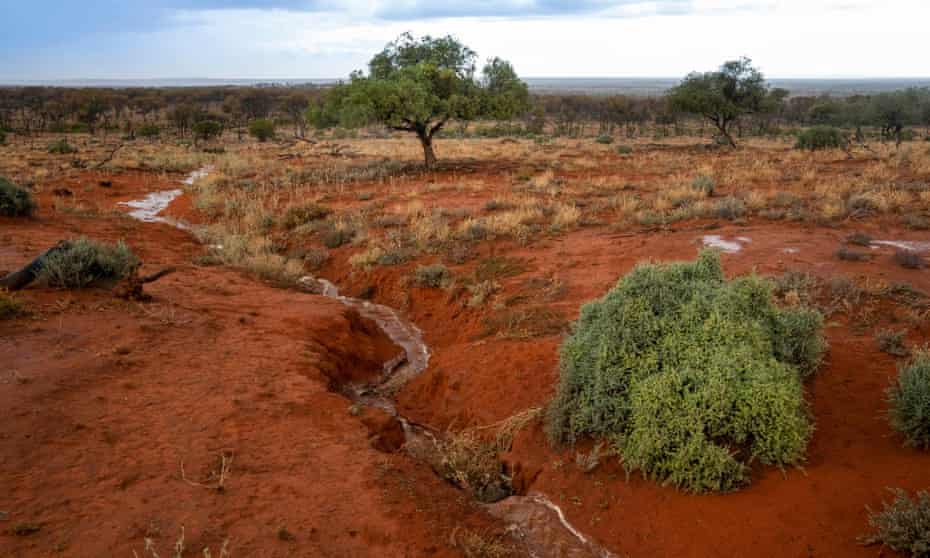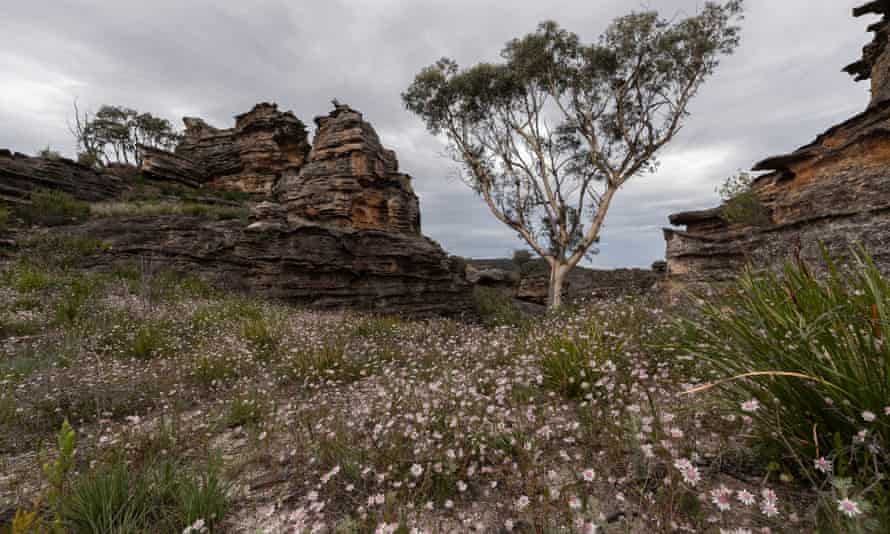‘Boots on the ground’ needed to make the most of NSW national park land purchases
State government urged to manage and resource recent property acquisitions to protect native species and habitat

In June last year, the New South Wales environment minister, Matt Kean, announced the acquisition of Narriearra station, a sweeping property on Karengappa country in the state’s north-west, for the national parks estate.
Dotted with huge temporary wetlands that fill and attract waterbirds during inland floods, the 153,415 hectare outback cattle station was the single largest purchase of private land for a national park in the state’s history.
This year, the government made further purchases in the far west, adding Langidoon and Metford stations and Avenel/Mount Westwood station near Broken Hill and Koonaburra station near Ivanhoe to land that will be protected for conservation.
The acquisitions have marked the reversal of a trend that the head of the National Parks Association of NSW, Gary Dunnett, says saw the establishment and expansion of reserves come to an “abrupt end” after the Coalition won power in NSW.
It’s a move that has seen Kean praised by the environment movement, though Dunnett adds it must come with adequate resources for environmental management.
Legislation introduced by Kean to the NSW parliament this week proposing substantial changes to laws that govern national parks has also raised alarm bells from the NSW opposition, crossbench and the conservation movement.
“Because we’ve had this long hiatus, we’ve got a national parks service that’s gone through efficiency dividends in that time. So from our perspective, they’re starting from a low point,” Dunnett says.
“It’s really important that these new lands come with resourcing packages and it is notable that none of the press releases to date have actually talked about that component.”
Iconic but vulnerable
Since becoming environment minister, Kean has targeted national parks for much of the biodiversity work required of the portfolio.
Conservation protections on other types of land tenure have been a source of division within the government, most notoriously with the “koala wars” that nearly split the Coalition in 2020.
Kean initially set a target to add 200,000 hectares to the state’s conservation estate but doubled it to 400,000 by 2022 after reaching that figure almost a year early.
The state has now added more than 500,000 hectares for protection since August 2019, which Dunnett says brings NSW closer to its historical average of about one million hectares a decade.
Most of the new acquisitions have occurred in the state’s west, a region with unique ecosystems and species that are under-represented in the conservation network.
About 9% of land in NSW sits inside protected areas. West of the Great Dividing Range the figure was closer to 3% before the new acquisitions.
“They seem to have done a really good job of picking places that bring the best benefit from a biodiversity perspective,” Dunnett says.
Pepe Clarke, the deputy director of conservation organisation the Pew Charitable Trusts, says the scale of the recent investments is welcome, and hopes it is a signal there will be greater investment in the management of parks in the years ahead.
“Outback Australia is one of the last remaining intact natural places on earth, but much of our unique wildlife and iconic landscapes remain threatened or vulnerable,” he says.
“In NSW, once you get west of the Great Dividing Range, wildlife habitat is woefully under-protected. Without greater active management and increased protection, many native species will continue to decline.”
Clarke says to fulfil their potential, the properties will need to be managed with “boots on the ground” and, once livestock is removed, through work to address key threats, including noxious weeds and feral pests, particularly goats.
Natural capital
The NSW government has said little to date about how the new parks will be managed and resourced, with plans for each in development.
When the Narriearra acquisition was announced last year, WWF-Australia called on the government to make sure the new park created jobs for traditional owners who should be able to use the site and be central to the conservation of cultural areas and artefacts.
Rocky Robertson, the chief executive of the Tibooburra Local Aboriginal Land Council, told Guardian Australia that since that time the council and other Aboriginal people with ties to the land had had “a lot of involvement in the setting up of the new site”.
In terms of resources, the government says the number of full-time equivalent staff across the entire national parks and wildlife service is 2,014, up from 1,633 in 2019.

It says it is making the biggest investment – about $450m up to 2022-23 – in visitor infrastructure in NSW national park history and will under take the largest feral animal control program to occur across the reserve system.
For the Narriearra Caryapundy Swamp national park and the Langidoon and Metford and Koonaburra sites, the government says there will be a total of six new positions added to existing parks teams.
It says about $750,000 additional capital and operating expenditure has already occurred for these sites, on top of $1m spent on establishing a camp ground, roads and cultural heritage surveys and biodiversity surveys at Narriearra.
Dunnett says the extra capital expenditure is welcome but there is “no information upon which to base any judgment of the adequacy of this allocation”.
And he says the additional six staff roles represent just 0.3% of the total parks workforce, which falls short of a proportionate increase to staffing levels when the area of protected land in NSW has increased by 7.35%.

A government proposal to use national parks to create credits to sell in the state’s biodiversity offset market also prompted major concern and accusations of “statewide greenwashing” last week when it was introduced as part of a bill presented to the NSW parliament without consultation.
Labor and the crossbench have said they will oppose the legislation in its current form, despite welcoming aspects of the bill, including necessary changes to laws to expand the Gardens of Stone national park in the Blue Mountains.
Bev Smiles, the vice-president of the Central West Environment Council, says the interest now will be in how the government deals with the environmental issues at each of the new parks and how it uses parks management to improve employment opportunities for local residents.
“I’ve always advocated and there’s a real opportunity to have more local employment from natural resource management,” she says.
Quick GuideHow to get the latest news from Guardian AustraliaShow

Email: sign up for our daily morning briefing newsletter
App: download the free app and never miss the biggest stories, or get our weekend edition for a curated selection of the week’s best stories
Social: follow us on YouTube, Facebook, Instagram, Twitter or TikTok
Podcast: listen to our daily episodes on Apple Podcasts, Spotify or search “Full Story” in your favourite app
“Our natural capital is something that needs to be invested in.
“If that investment includes jobs through the local land service and national parks and wildlife service and employing rangers and local young people then it’s a really good outcome for everybody.”
Smiles adds it would be possible to find threatened species on just about every piece of land out west.
She says given the size of the new sites, once they are destocked and managed for conservation “there would actually be quite a bit of bounce-back”.
‘Green lungs next door’
Simon Molesworth is an environmental QC, pastoralist and the head of Landcare Broken Hill.
He says the acquisition of the new sites has not been welcomed by the whole community, with some agricultural land owners concerned about what they see as growing competition for property.
“What they’re saying is the government can outbid anyone and take these properties out of circulation,” Molesworth says.
“But for the viability of rural Australia we need to have balance. If every property is producing, you then don’t have what I call the green lungs next door.”
Molesworth himself has seen the degree of ecological bounce-back that can occur, having destocked his own properties three years ago to manage them for conservation.
He says saltbushes, native grasses and low-lying shrubs have “come back magnificently”, even with minimal rain.
“My view is you need to adopt the long-term perspective,” he says. “The climate is changing and it is responsible for governments to acquire large areas of land to become biodiversity and carbon sinks.
“We do have to safeguard the biodiversity of the far west. I can observe that those that did destock, it’s extraordinary the degree of bounce-back.”